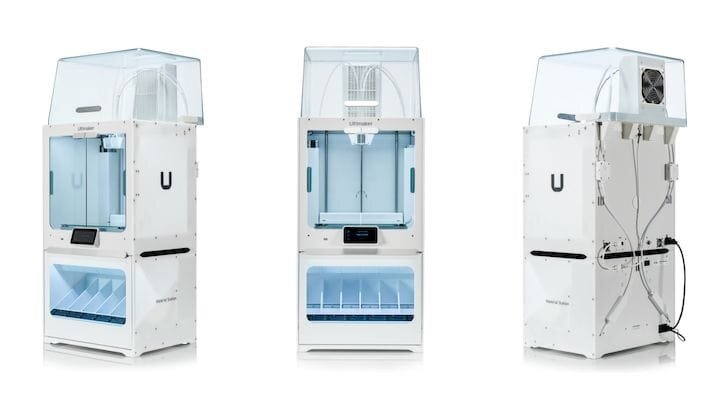![The Ultimaker S5 Bundle [Source: Ultimaker]](https://fabbaloo.com/wp-content/uploads/2020/05/ultimaker-s5-bundle-sides_img_5eb09003f1050.jpg) The Ultimaker S5 Bundle [Source: Ultimaker]
The Ultimaker S5 Bundle [Source: Ultimaker]
Ultimaker made good on their promise to announce something special today, and it turns out to be the “Ultimaker S5 Bundle”.
We speculated on what they might announce, as they previously previewed a teaser image. We analyzed the rather dim image and had several thoughts about what the company might be announcing. You can read our Ultimaker announcement speculation here, some of which turned out to be very close to the actual announcement. (And some very much not.)
3D Printing Temperature and Humidity
The Ultimaker S5 Bundle attacks one of the key challenges to high-quality, reliable 3D printing: environmental management. While the S5 3D printer is the same unit we’ve seen for over a year now, with its powerful material profile system, this announcement has to do with both temperature and humidity.
Prints taking place in an ambient atmosphere face a tremendous challenge: the temperature difference between the hot end extrusion of 200C+ and a comfy room temperature of, say 20C. That 180C difference causes a whopping temperature gradient between the freshly extruded material and the much colder earlier extrusions. Inevitably, warping occurs.
This is somewhat managed by heated build plates, but for larger prints in particular, the mid-sections of the print are too far from the hot plate to gain much benefit.
Ultimaker Air Manager
![The Ultimaker S5 Bundle’s Air Manager [Source: Ultimaker]](https://fabbaloo.com/wp-content/uploads/2020/05/ultimaker-s5-bundle-air-manager_img_5eb09004481b8.jpg) The Ultimaker S5 Bundle’s Air Manager [Source: Ultimaker]
The Ultimaker S5 Bundle’s Air Manager [Source: Ultimaker]
Now Ultimaker rectifies this problem by introducing a heat capture system in the Ultimaker S5 bundle, called the “Ultimaker S5 Air Manager”. The centerpiece of the system is a clear lid that fits over top of the previously wide-open S5 3D printer. This enables capture of any heat generated in the build chamber and thus raises the ambient temperature during the print.
The Air Manager system also includes a ventilation fan, presumably to lower the temperature if necessary. That suggests that the system is capable of reaching relatively high temperatures. It is not just a lid, as its function fully meets its name, “Manager”.
This feature alone should make Ultimaker S5 prints of much higher quality and reliability, particularly regarding dimensionality of printed parts.
Ultimaker Material Station
![The Ultimaker S5 Bundle’s Material Station [Source: Ultimaker]](https://fabbaloo.com/wp-content/uploads/2020/05/ultimaker-s5-bundle-material-station_img_5eb090048478c.jpg) The Ultimaker S5 Bundle’s Material Station [Source: Ultimaker]
The Ultimaker S5 Bundle’s Material Station [Source: Ultimaker]
But that’s not all. Ultimaker also includes a material storage system in the bundle, called the “Ultimaker S5 Material Station”.
This is a large container upon which the printer itself sits. Inside the Material Station is room for six standard-sized filament spools, which are stored in a low-humidity environment. The Material Station feeds filament directly to the dual extruders on the S5 above it.
The Material Station achieves the low humidity by including a “regenerating” silica gel that extracts moisture from the air within the Material Station. Ultimaker says it can maintain 40% humidity even if the ambient conditions are as high as 70%. It’s not clear how the silica gel is regenerated, but perhaps there is some approach for removing its absorbed moisture to outside the station.
Ultimaker says that the Material Station removes the need for constant supervision, which I take to mean that there likely is an ability for the station to somehow switch filaments spools when one runs out. This puts the S5 on par with major production 3D printers that have the same feature.
Ultimaker Production 3D Printing
![Using the Ultimaker S5 Bundle for 3D print production [Source: Ultimaker]](https://fabbaloo.com/wp-content/uploads/2020/05/ultimaker-s5-bundle-loading_img_5eb09004c5349.jpg) Using the Ultimaker S5 Bundle for 3D print production [Source: Ultimaker]
Using the Ultimaker S5 Bundle for 3D print production [Source: Ultimaker]
With the bundle S5 operators can be assured their very large 3D prints will complete with a low probability of failure, with high quality and potentially all unattended.
That’s a game-changer.
Why? Because the price of the S5 Bundle is set at US$9,100, with availability in mid-October. While this price is a fair bit higher than a typical high-end desktop 3D printer system, the production capabilities of the Ultimaker S5 Bundle are now more or less equivalent to much higher-priced production systems.
The only major feature missing from this bundle might be a way to automatically unload prints, but perhaps that’s something they’re saving for another day.
Via Ultimaker

